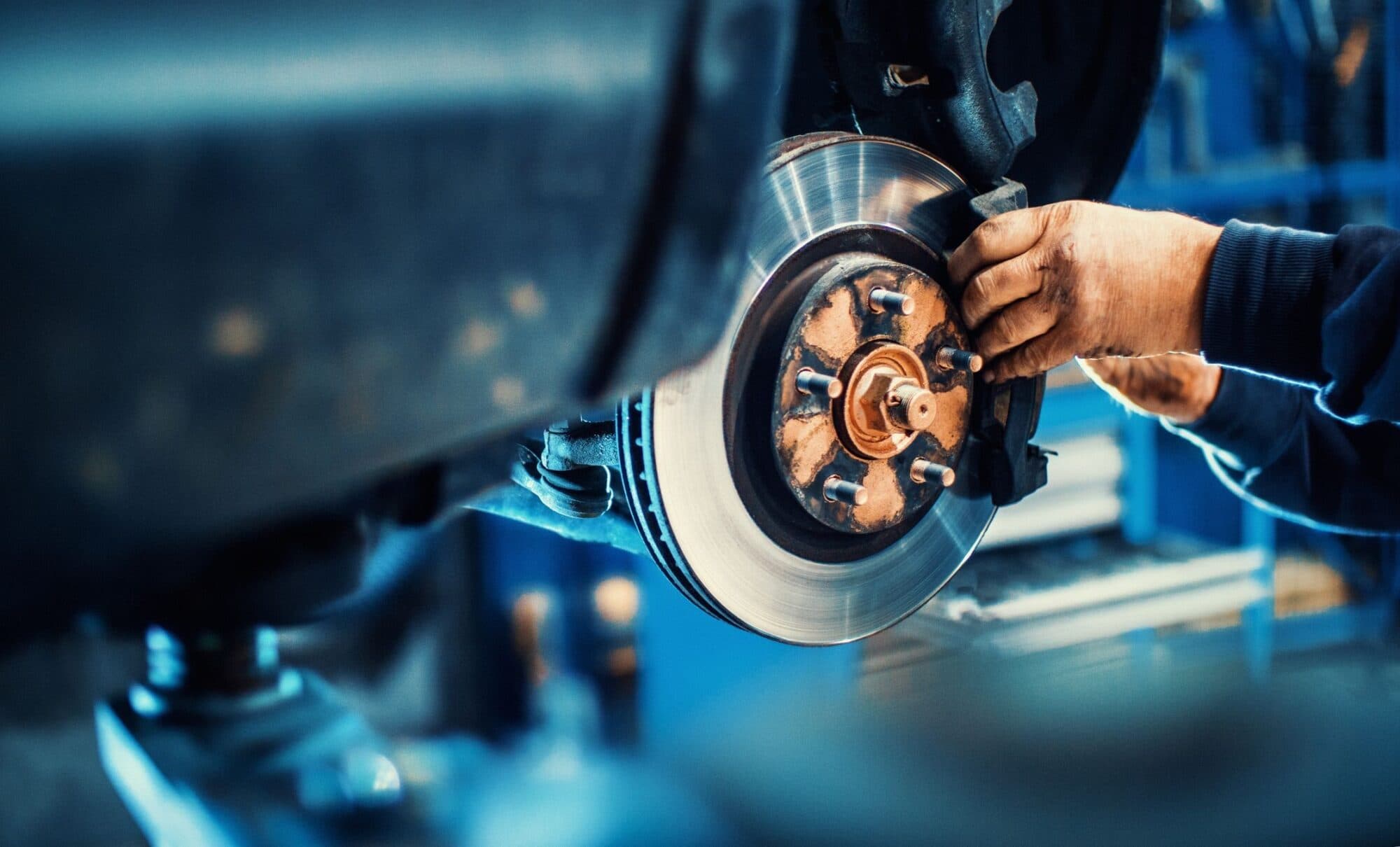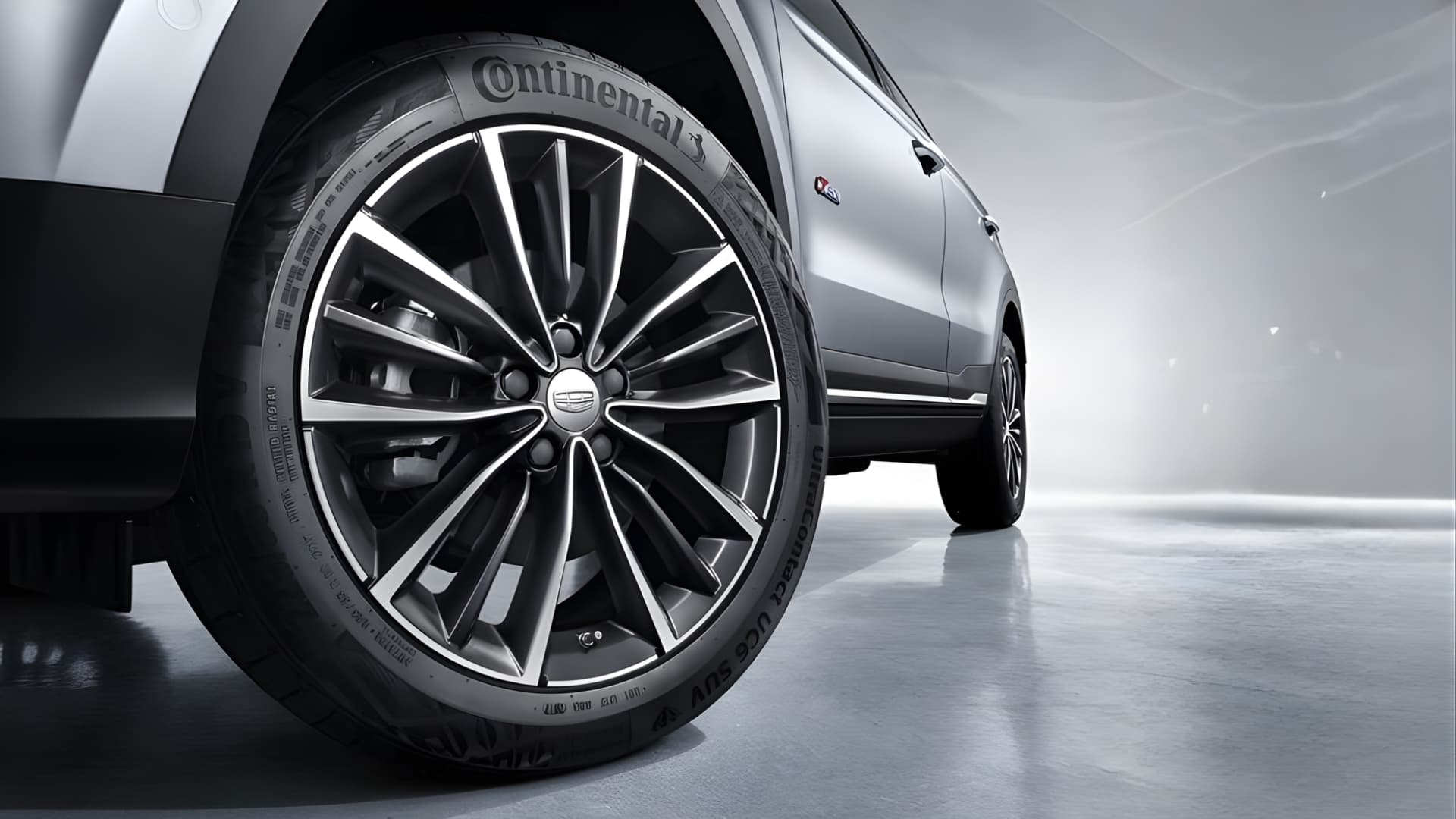
Maintaining your vehicle’s braking system, specifically the brake pads, is paramount to ensure its efficiency and safety. In this guide you will find out all that you need to know about properly checking on and servicing them. It covers from knowing why they are important for avoiding wear-outs up until how their lifespan can be extended with proper maintenance techniques. Thus granting your car an optimal condition of performance as well as security over time.
Key Takeaways
- Regular inspection and maintenance of brake pads is essential to ensure vehicle safety and performance.
- Adopting good driving habits, such as avoiding sudden stops or starts, can help reduce brake pad wear.
- Regular servicing and replacement of worn components in the braking system is necessary for safe operation and extending component lifespan.
Understanding Brake Pads
Brake pads are a vital element of the braking system, producing friction that slows down your wheels. As they deteriorate with usage over time, it is important to regularly check and change them so as to maintain good functioning levels and also protect other brake components from damage.
If you hear any clicking or squealing noises when applying brakes then it’s time for an inspection or service of these specific parts. Going forward, we will look more deeply into how brake pads work as well as examine the varieties most brake pads available on the market today.
How brake pads work
When a driver presses the brake pedal, it triggers hydraulic pressure that causes friction between the braking system and the rotor. This process results in slowing down or stopping of the vehicle’s wheels. Brake pads are parts of this car brakes apparatus, found on drum brakes specifically. They make contact with rotors to produce such acceleration. There exist various materials used for creating these pads, like metallic, ceramic or semi-metallic among others - each having their own heat/friction resistance abilities which will affect performance and longevity accordingly. Wear indicators are designed by manufacturers so drivers have an indication when it’s time to replace them in order to maintain their cars properly along with peak brake functionality.
To ensure top functioning from your braking system, you need to be aware of how brake pads operate, being mindful about material choice and then checking your brake pads regularly if wear indicators activate helps keep things running smoothly over time!
Types of brake pads
When it comes to new brake pads, there are several types available in the market. Each of these offers varying performance and can be best suited for different driving conditions. Semi-metallic brakes provide improved braking power along with consistency and greater gripping force which makes them suitable for high-performance cars, while Non-Asbestos Organic (NAO) offer a smoother ride at low temperatures without any damage caused by heat build up on the brake system or abrasions from generating too much dust as they wear away slowly over time. On the other hand, Low Metallic NAOs generate less noise but have shorter life spans when compared to their ceramic counterparts that last longer due to being able to withstand extreme temperature changes while producing lesser amounts of debris simultaneously. It is important that one understands all aspects related to each type before making an informed choice so that you get optimal use out of your vehicle’s rotors without compromising safety in anyway whatsoever.
When to Check and Service Your Brake Pads
Regular inspection and servicing of brake pads should not be neglected for the best performance as well as safety. If you ignore warning signs that your brake pads are worn out, it could cause a decrease in braking power which is dangerous. Not changing them when necessary also puts extra pressure on the brake disc and rotor causing additional wear to occur quickly. How often should brakes need checking? It’s advised to check around every 6 months or 15000 miles according to one’s driving style, conditions and what type of vehicle they have, etc. If you hear screeching noises from the area or find worn indicators against rotors indicating lessened breaking force, then reviewing those elements right away would be wise advice!
Regular inspection intervals
The regular checking of brake pads is key to detecting potential issues, averting Harm and being mindful of other concerns regarding the vehicle. Factors such as driving style, type of brakes installed on the car, driver behaviour and climate conditions determine how frequently one should inspect their brakes. For instance, urban drivers may experience quicker deterioration due to constant acceleration/deceleration when stuck in traffic-heavy areas. The suggested window for conducting a brake pad check lies between 20K - 60K miles or once every six months. An interval that needs additional consideration if you live somewhere with extreme temperatures since it can affect elements within your braking system more quickly than expected. Thus having routine inspections will ensure your car's brake system continues performing safely at its highest level possible.
Signs of worn brake pads
Indicators of when brake pads are worn include: a squeaking or grinding noise, vibration in the pedal and slower stopping. Often accompanied by lessened brake dust. It is important to address this problem immediately so that damage to your braking system can be avoided. A very squeaky brakes scraping sound will typically signify it’s time for replacement, as does having one side pull during application on the brakes. An inspection should then occur of the front tire associated with said motion. Paying attention to these warning signs contributes greatly to keeping your vehicle safe and functioning correctly at all times!
Step-by-Step Guide to Checking Brake Pads
Inspecting the brake pads is essential to identify any potential issues and avoid additional damage. To ensure your car’s braking system stays in optimal condition, you should inspect the brakes checked using them regularly. We will provide a step-by-step explanation of how to do this visually through the wheel holes as well as show what it entails when removing the wheels for an even more precise inspection.
1. Visual inspection through wheel holes
Using a flashlight to peek through wheel holes, you can check brake pad thickness and wear indicator tab. The pads should be at least 1/4” thick or else they need replacing. Near the top of each brake pad is an indication slot that shows how much erosion has occurred. If it’s no longer visible, then replacement should occur soon. When these tabs scrape against rotors with a distinct squealing sound– another sign it needs attention – you know your vehicle’s brakes are in danger of wearing down completely unless addressed promptly by changing out all necessary parts within the system for optimal functioning and safety on roads.
2. Removing the wheel
To perform a more meticulous inspection, it is beneficial to remove the wheel and examine the brake pads, caliper, rotor and lines. To do this you will need protective gloves as well as lug wrench/breaker bar tools. To a jack or stands. Abide by your car manufacturer’s guidelines for new brake pad installment. Ensuring proper installation for maximum protection of brake functions.
Once removed thoroughly inspect the friction material found on your brake pads with great care. If their thickness dips below 4mm, replacement must take place immediately! Ensuring all features of brake service are fully operable makes sure that any braking system remains safe at all times when running out on roads again.
Servicing and Replacing Worn Brake Pads
To ensure your vehicle’s performance and safety, replacing worn brake pads regularly is a must. Routine maintenance of the brakes should include servicing and changing out any damaged parts like callipers, rotors or tires in order to maintain optimal braking ability on the car.
In this article we will be discussing how to choose suitable brake pad replacements for your auto as well as going through instructions for their installation procedure.
Choosing the right brake pads for your vehicle
When it comes to choosing the appropriate brake pads for your vehicle, there are certain aspects that need to be considered. Firstly, you must take into account the current state of your brakes and expected lifespan of the pads, second is noise level control due to metal content in one brake pad composition as well as material used, third is specifications related to braking system size & weight needed for a particular car model. These will all help make an informed decision when selecting suitable components for optimal performance and safety of one’s automobile.
Driving conditions may also dictate what type/brand they should go with such factors as heavy loads on board or frequent stop-and-go traffic which entails hard breaks moments at points accompanied by possible hilly terrains where quick halts have a higher chance happening simultaneously seem necessary pieces hints while making this sensible choice regarding top notch quality product selection process accordingly avoiding any Hassle leading to potentially hazardous outcomes. By keeping these information handy so next time shopping occasion arises shoppers aware of what not specifically looks but how best works better options same circumstances even beyond original expectations levels enabling smooth rides ahead their road trips journeys permanently benefiting experience full confidence peace mind trust feel knowing right decisions have been taken truly delivering satisfied end results overall every single instance served greatness always!
Brake pad replacement procedure
The guidelines provided by the manufacturer must be adhered to for proper brake pad installation and performance. The process of replacing brake pads can consist of these steps: removing the wheel, undoing the slider bolt, lifting up the calliper arm followed by sliding out old pads. In order to guarantee optimum safety while exchanging brake components, it is necessary that you exercise caution in activities such as draining fluid from brakes, putting on protective gear before working on them and pressing after new ones are fitted. More one should lift vehicles carefully and also inspect their level of fluids regularly once done with this maintenance task. By following all these precautions when undertaking a job like changing brake accessories one can make sure their vehicle’s braking system functions without fail safely.
Maintaining Other Brake System Components
The brake system of your car must be regularly inspected and maintained for optimum efficiency, with special attention being given to the pads. Other components of brake failure such as rotors, callipers and fluid lines are also part of the overall braking performance that needs to be taken into account. Keeping all these parts in working order will ensure you have a safe and secure vehicle every time it is driven.
It is essential to not only inspect brake pads but look at other areas like rotors, callipers, etc., which help guarantee an efficient car when travelling on roads or highways.
Brake rotors
The wear and tear that brake rotors can experience with time should be monitored. Symptoms such as loud squeaking, scraping noises when turning the steering wheel, a vibrating feeling within said device or irregular pulsations from the brakes plus any observable damage on the rotors must all serve to alert owners of potential problems in their braking system. Thus it is essential for them to pay attention so they can inspect brake repairs and potentially replace these components if needed, this will ensure safety levels are maintained while driving vehicles using those same rotor parts.
It’s advisable that people who own cars consider replacing their old worn-out versions before reaching “Worn Rotor Minimum Thickness”. After all, we don’t want anything going wrong with our car due to its malfunctioning brakes! And by checking regularly both brake pads along warped rotors with their respective sensors, we guarantee continued good service provided through an effective use of this type of vehicle technology feature.
Brake calipers
The performance of the braking system depends greatly on brake calipers, which should be regularly inspected for signs of damage or wear. For example, a squealing noise from the brakes can indicate an issue and having to press down too hard on the brake pedal could mean that there is something wrong with them. If you find your vehicle pulling towards one side when applying brakes, it might also signal problems with these parts. Any sign of fluid leakage at caliper level would certainly call for their replacement or repair right away as soon as possible in order to keep overall system functioning optimally safe operation. Thus regular inspections are recommended both to identify potential problems but also maintain good functions up top standard so our vehicle will remain safe and operable behind the wheel all times.
Brake fluid and lines
The braking system relies on brake and hydraulic fluid, and lines to transmit pressure from the pedal to the pads. To ensure that these components are functioning properly, it is essential to regularly inspect them for any signs of leakage or damage. If there is a low level of brake fluid in the reservoir or if you see yellow-brown liquid underneath your vehicle, this may be indicative of an issue and should be addressed immediately. Performing regular maintenance checks can help stop issues before they develop, thereby maintaining optimal performance within your brakes overall functionability.
Preventing Brake Pad Wear and Prolonging Their Lifespan
Maintaining your brake pads by practicing good driving habits and scheduling regular maintenance can help prolong their lifespan. You should minimize sudden stops, hard braking or heavy loads to reduce wear on the brake pads as this will improve performance and safety over time. It is important to regularly check and replace them for optimal results. Through these practices, you can ensure that your brakes remain efficient and reliable at all times.
Driving habits
It is possible to prolong the life of your brake pads and minimize their wear by making some changes in driving style. For instance, try not to accelerate or decelerate suddenly. Instead attempt coasting when practicable and don’t ‘two-foot’ (push both accelerator & brakes simultaneously) the pedals. Make sure that you lessen any burden on your vehicle’s brakes as much as possible.
These tweaks will help decrease brake pad damage while better the rear brakes and protecting them from longterm harm due to extensive usage.
Regular maintenance
It is important to keep a regular check on the braking system and service it for better performance as well as making brake lines and pads last longer. Every 12,000 miles inspect your brakes’ lining and swap out any with less than 1/8-inch of pad remaining. Through routine maintenance of the vehicle’s braking apparatus you will be able to guarantee safety while improving efficiency plus enhancing longevity of the break pads themselves.
Summary
Maintaining your vehicle's brake pads is crucial for ensuring safety and optimal performance on the road. Familiarizing yourself with the signs of wear, understanding the right time for inspections and services, and learning how to properly check and replace worn brake pads are vital steps in keeping your braking system functioning correctly. Adopting good driving habits and adhering to a regular maintenance schedule can significantly prolong the lifespan of your brake components, ensuring your vehicle operates smoothly and safely.
Don't wait for an emergency to arise. Be proactive in safeguarding your vehicle's safety by regularly checking, servicing, and replacing worn brake pads. For expert assistance, visit Westside Auto Service, the largest car service and repair centre in Perth, WA. Trust us to keep your vehicle in top condition and give you peace of mind on the road.
Frequently Asked Questions
How do you check your brake pads?
To check your brake pads, look through the dust shield on the caliper and estimate their thickness. If the linings are too worn or the pads are less than 1/4” thick, they should both need to be replaced. You might need a flashlight to get a good look and some pads have a wear indicator slot down the center to help you determine when replacement is needed.
Do they check brake pads on service?
At every service, it is recommended to check the condition of your brake pads. This is an important step in the right direction.
Why is my car telling me to check my brake pads?
The warning light on your car is a sign that you should take the time to check and potentially replace your brake pads as they have become worn down due to their wear sensors, or it could be an indication of low brake fluid levels or problems with parking brakes adjustment.
What are the signs that my brake pads need replacement?
If you notice a squeaking or grinding noise, vibrations in the brake pedal when stopping, slowed braking performance and less dust from your brakes, then it’s likely time to change out your brake pads.
How do I know which type of brake pad is best for my vehicle?
When selecting the optimal brake pad for your car, you should consider both its make and model. To how it is used. Think about which material will best suit your needs from available pads on offer.




